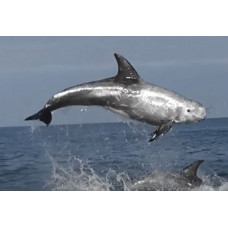Latin name
Grampus griseus
Other names
Grampus griseus
Identification
Risso's dolphin lacks the typical beak of other dolphins. It has a relatively large front body and dorsal fin, while the back tapers to a relatively narrow tail. The convex shape of the head has a vertical wrinkle at the front. Most animals have two to seven pairs of teeth, all on the lower jaw.
Features of fish fins
Pectoral fins are slender and long. The dorsal fin is high, deeply carved on the posterior margin and slightly displaced towards the anterior half of the body.
Fish colouring
There are bright spots, stripes and scratches scattered over the body, caused by the teeth of congeners and molluscs. Juveniles are grey-brown dorsally and cream ventrally, with an anchor-shaped white area between the pectoral muscles and around the mouth. In older calves the non-white areas darken to almost black and then lighten (except for the always dark dorsal fin). Older individuals are mostly white.
Distribution
They live in almost all parts of the world, from cold and temperate to tropical waters, in the Indian, Pacific and Atlantic Oceans, as well as parts of the Baltic Sea, the Persian Gulf and the Mediterranean, North and Red Seas, with the exception of the Black Sea.
Habitat
Their preferred habitat is near the continental shelf, on steep banks, with water depths of 400-1000 m (1300-3300 ft) and water temperatures of at least 10°C (50°F), preferably 15-20°C (59-68°F).
Size
An adult can weigh between 300 and 500 kg. It is up to 4 metres long. As with most dolphins, males are usually slightly larger than females. It is the largest species.
Behavior
They prefer to live in open waters and are rarely found in coastal areas. Mainly nocturnal.
They have a stratified social organisation. They usually travel in groups of 10 to 51 individuals, but can sometimes form groups of up to several thousand individuals. Smaller, stable sub-groups exist within larger groups. These groups tend to be similar in age or sex. Risso's dolphins are fiercely loyal to their groups and their young.
They have been recorded diving to depths of up to 600m (2,000ft) in pursuit of prey.
Have a life expectancy of 30 years.
Food and feeding habits
It feeds primarily on neritic and oceanic squid and cephalopods. Risso's dolphins do not need teeth to process cephalopod prey, but use them as a show weapon in mating conflicts.
Reproduction
The pups are born in winter and reach sexual maturity when they are three metres long. Hybrids with common bottlenose dolphins are known to occur. Pregnancy lasts about 13-14 months with an interval of 2.4 years. Seasonal calving peaks in winter in the eastern Pacific and in summer and autumn in the western Pacific. Females reach sexual maturity at 8-10 years and males at 10-12 years. The oldest individual was 39.6 years old.
Fishing
In countries like Japan and Sri Lanka, people eat Risso's dolphin meat, so their numbers are dwindling.
Human interaction
Risso's dolphins pose no threat to humans. They are caught in trawls and gillnets around the world, often to their death.
| Classification | |
| Phylum | Chordata |
| Class | Mammalia |
| Squad | Artiodactyla |
| Family | Delphinidae |
| Genus | Grampus |
| Species | G. griseus |
| Features | |
| Conservation status | Least Concern |
| Habitat | Pelagic |
| Life span, years | 39,6 |
| Maximum body weight, kg | 500 |
| Maximum length, cm | 400 |
| Sailing speed, m/s | No information |
| Threat to people | Edible |
| Way of eating | Not a predator |
Risso's dolphin
Tags: rissos dolphin


